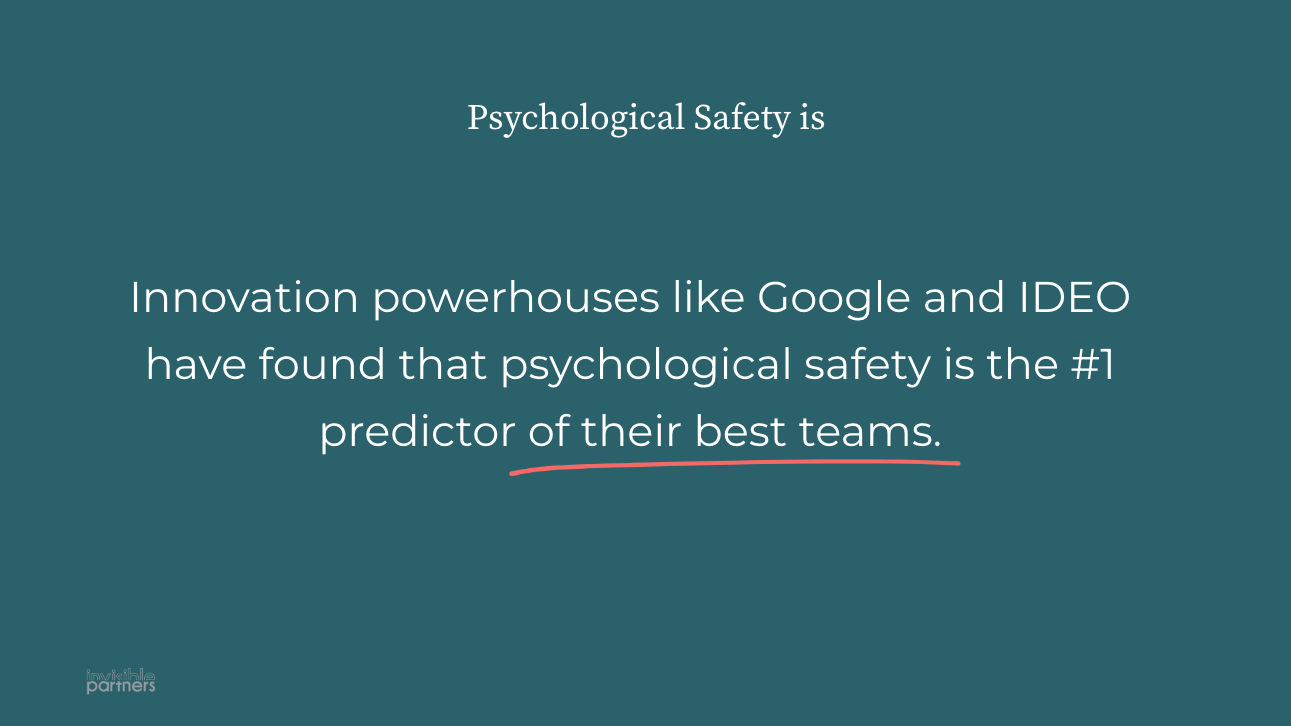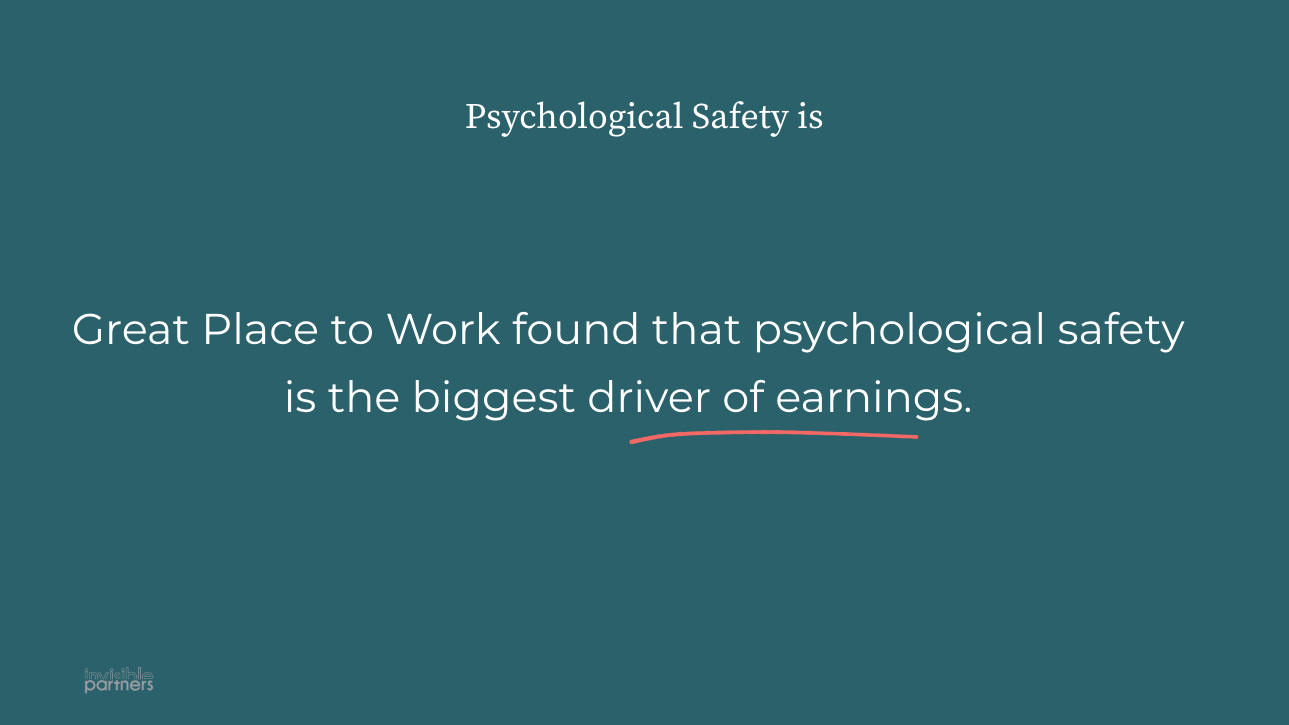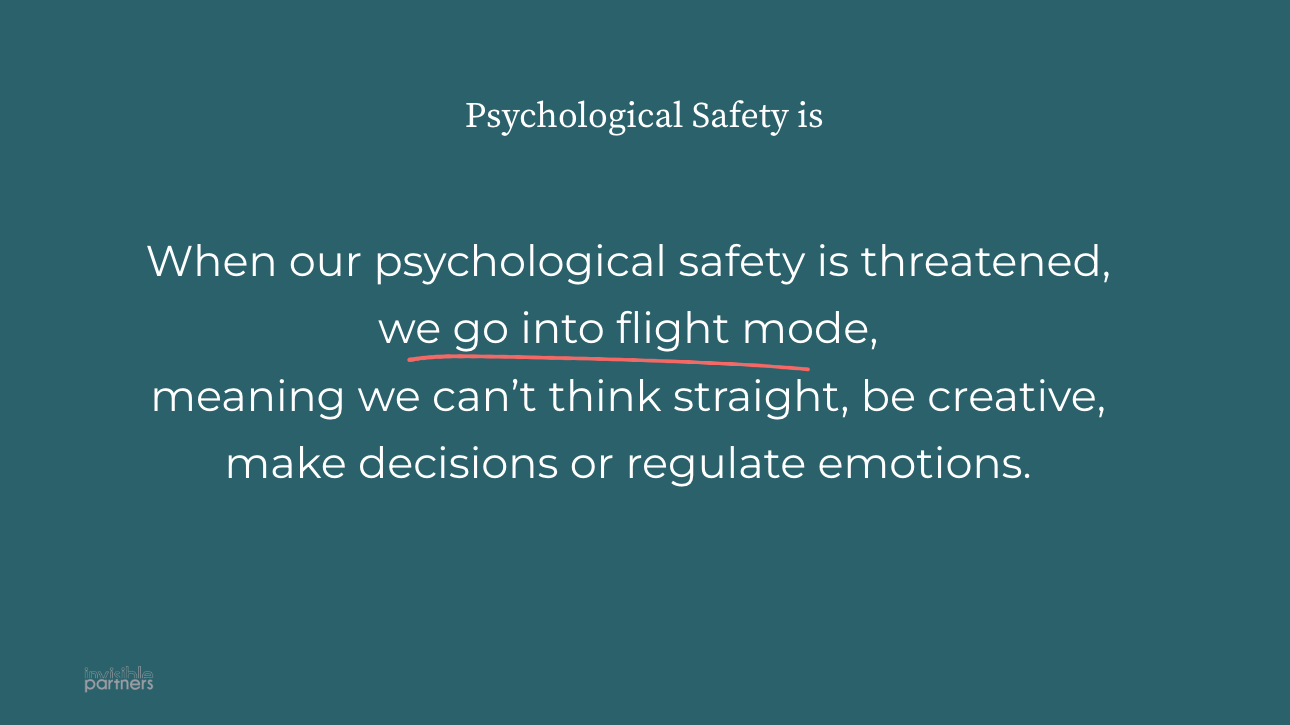Strategies to cultivate a Psychological Safe workplace
Sure, treating people with respect and civility are important parts of a workplace that won't make you feel like you're in the Hunger Games.
But psychological safety is much deeper, and more mutually beneficial than that.
At it’s core, psychological safety is…
Psychological safety means that you feel safe to speak your mind, throw out ideas, ask questions, and even admit when you've made a mistake without the fear of being punished or humiliated. It can feel like always having a life preserver in the choppy waters of work life.
When you're in a psychologically safe environment, you're free to take appropriate risks without feeling like you’ll be reprimanded if things don’t work out. You can be yourself, speak up, and take chances knowing that you won't be ridiculed for being the office oddball.
Creating a culture of psychological safety is not an easy feat. It takes effort, intention, and a whole lot of courage. You have to be willing to foster an environment where people feel comfortable being themselves and expressing their thoughts without the fear of judgment.
Psychological safety is more than just being polite and courteous. It's about creating an environment where everyone feels free to be themselves, take risks, and grow.
The legal requirements
Ah, the good ol' Work Health and Safety Act 2011 - a real page-turner! Under this act, employers have a duty to ensure the health and safety of their workers. Here’s the main premise:
A person conducting a business or undertaking has a primary duty to ensure, so far as reasonably practicable, both the physical and psychological health and safety of their workers.
…and psychological!
So much effort, resources and planning have gone into mitigating physical risks at work and yet psychological risks in Australian workplaces remain about as regulated as a game of backyard cricket. But with the rising costs of psychological injuries and a few legislation reviews, State and Territory Ministers have finally committed to introducing regulations to take psychological health and safety seriously.
Basically, these new regulations recognise that psychosocial hazards are just as harmful as physical ones, and they give employers clearer guidance on their obligations to protect workers from mental illness and injury. And, to help out, SafeWork Australia released a Code of Practice on managing psychosocial hazards at work.
As of October 1, 2022, NSW became the first state to adopt new regulations, so now businesses operating under NSW law are required to manage psychosocial risks.
Queensland followed suit on April 1, 2023.
So, if you're an employer, get ready to manage psychosocial hazards just like you already do for physical ones. You'll need to follow a systematic approach, consult with staff, identify risks, assess and prioritise them, develop control measures, and regularly review their effectiveness.
A Psychologically Safe work environment is great for business.
In 2015, Google embarked on a mission to uncover the secrets of high-performing teams through Project Aristotle. After analysing hundreds of teams, they discovered that the main predictor of a successful team was psychological safety.
Creating a safe environment is not just good for team morale, it's good for business. Great Place to Work has been studying this for 30 years, and their research shows that psychological safety is the biggest driver of earnings.
A Psychologically Unsafe work environment is horrible for humans.
In contrast, there’s a real problem for many humans who don’t feel psychologically safe in the workplace. In Australia, statistics show that only 23% of lower-income employees and 45% of higher-income employees feel like they work in a psychologically safe environment.
But here's where things get interesting…
Recent advances in neuroscience have shown that psychological safety is not just important for teams success factor, it's also critical for our own health and well-being. Turns out, the same part of the brain that processes physical pain also handles emotional pain and rejection. That means that a lack of psychological safety can hurt just as much as a punch in the face. Ouch.
And when our psychological safety is threatened, our brains go into our inherent stress response, which can seriously mess with our cognitive abilities. In other words, we can't think, be creative, make decisions, or regulate our emotions when we feel threatened. So, creating a safe work environment isn't just the right thing to do, it's also the smart thing to do.
What impact does it have on a workplace?
WITH IT
Increased creativity and innovation: When employees feel psychologically safe, they are more likely to share their ideas and take risks. This can lead to more creativity and innovation within the workplace.
Improved collaboration and teamwork: When employees feel safe expressing their opinions and ideas, they are more likely to work together and collaborate effectively. This can lead to stronger teams and better outcomes.
Higher employee engagement and satisfaction: Employees who feel psychologically safe are more likely to feel engaged in their work and satisfied with their jobs, leading to a more positive work environment.
Great employee retention rates: When employees feel psychologically safe, they are more likely to feel a sense of loyalty and commitment to the organisation. They are more likely to see themselves as part of your team, and they may feel confident that they’re able to achieve their current and future work goals within your organisation.
Greater willingness to learn and develop: When employees feel safe to make mistakes and ask for help, they are more likely to take on new challenges and learn new skills. This can lead to a more skilled and knowledgeable workforce.
Improved mental health and well-being: A psychologically safe workplace can help reduce stress and anxiety, leading to improved mental health and well-being among employees.
WITHOUT IT
Fear of speaking up or making a mistake: Employees may be hesitant to express their opinions or concerns, for fear of being criticised, ostracised, or punished. If you feel unsafe, you may not speak up about a mistake you’ve made, taking away the opportunity learn from it as a business, or even more dire consequences.
Lack of trust: When employees do not feel safe to express themselves, trust can be eroded between coworkers, teams, and management.
Low morale and motivation: When employees feel disrespected or unsupported, they may become demotivated and disengaged from their work.
High turnover rates: A psychologically unsafe workplace can lead to high turnover rates, as employees may seek employment elsewhere in order to feel more valued and respected.
Reduced productivity and creativity: When employees do not feel safe to share their ideas or take risks, productivity and creativity can suffer.
Increased stress and anxiety: A psychologically unsafe workplace can lead to increased stress and anxiety among employees, which can negatively impact their physical and mental health.
Strategies to cultivate a Psychological Safe workplace
Be present
It's time to put down the phone, step away from the computer and actually engage with your colleagues. Active listening, eye contact and asking questions show that you're invested in what they have to say and that you value their contributions. Sure, it's tough to break free from the multitasking mentality, but it's time to make some meaningful connections instead of spreading ourselves too thin.
Understand
This involves showing that you're making an effort to comprehend what's being said, which can be done in a variety of ways. For example, you can use the technique of paraphrasing, such as "So what you're saying is..." or "Just to clarify, you mean...". By requesting further clarification, you're demonstrating your commitment to understanding the other person. Additionally, nonverbal cues such as leaning forward, nodding, and appropriate facial expressions can communicate that you're genuinely interested in what the other person is saying.
Avoiding blame
If you want to keep your team firing on all cylinders, creating a culture of psychological safety is key. But when employees feel like they'll be punished or judged for opening up about challenges or setbacks, it can be a real roadblock to progress. That's where a little phrase change can make a big difference. Instead of playing the blame game and asking "what happened and why?", try flipping the script and saying "how can we do better next time?". Not only does this approach encourage a focus on the future, but it also fosters a sense of shared responsibility and learning that can help your team bounce back stronger than ever.
Transparency
Letting others know how you work best, what recognition means the most to you, and your preferred communication style gives them a roadmap to interact with you in a way that feels supportive and respectful. It's like giving them the key to your brain's secret code, so they can understand and appreciate your unique quirks and strengths.
Stop negativity
Negativity is like a virus that can spread rapidly and destroy the psychological safety of a team. It can be tempting to ignore it, especially if you're the only one who wants to stop it. But just like practicing fire drills, having a plan and script for addressing negativity can help you respond more effectively in the moment.
Inclusive decision-making
This means encouraging everyone to share their thoughts and ideas and celebrating all contributions, even those that didn't align with the final decision. It's also essential to welcome healthy conflict, which allows for constructive feedback and the exploration of new perspectives.
Welcome conflict
Conflict seems contrary to a psychologically safe culture, but conflict gets a bad rap. With healthy conflict comes the ability to receive and provide feedback; particularly for leaders, this is essential for the optimal functioning of self and the team. Healthy conflict allows team members to challenge their leader and each other, which opens up the possibility of considering new or different perspectives. This enhances psychological safety.
Champion your team
As a leader or team member, it's important to champion your team and support their contributions. Instead of placing individual blame when a goal is missed, approach it as an opportunity for collaborative learning and troubleshooting. By doing so, you can create a psychologically safe environment that fosters growth and optimal team functioning.
We highly recommend checking this resources out:
Building a psychologically safe workplace | TEDx Talk by Amy Edmondson
People at Work | Australia's only validated and evidence based psychosocial risk assessment survey tool







